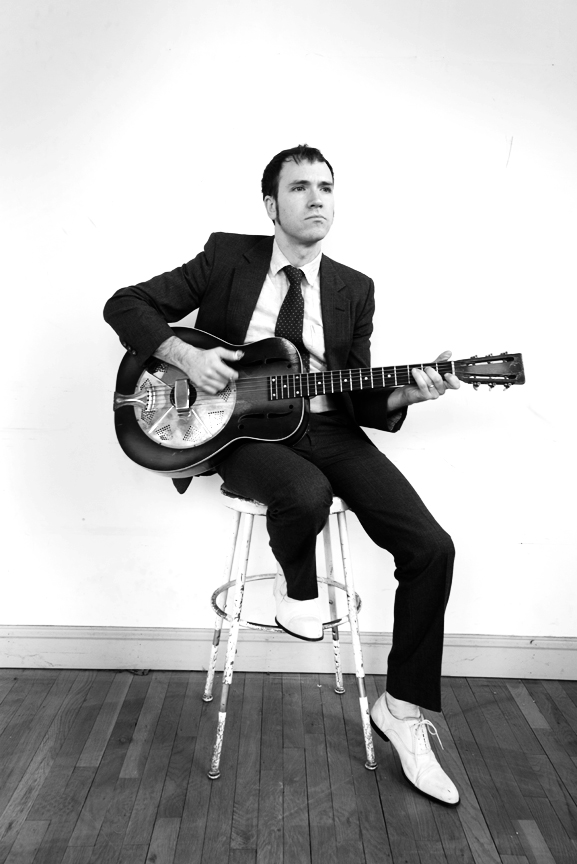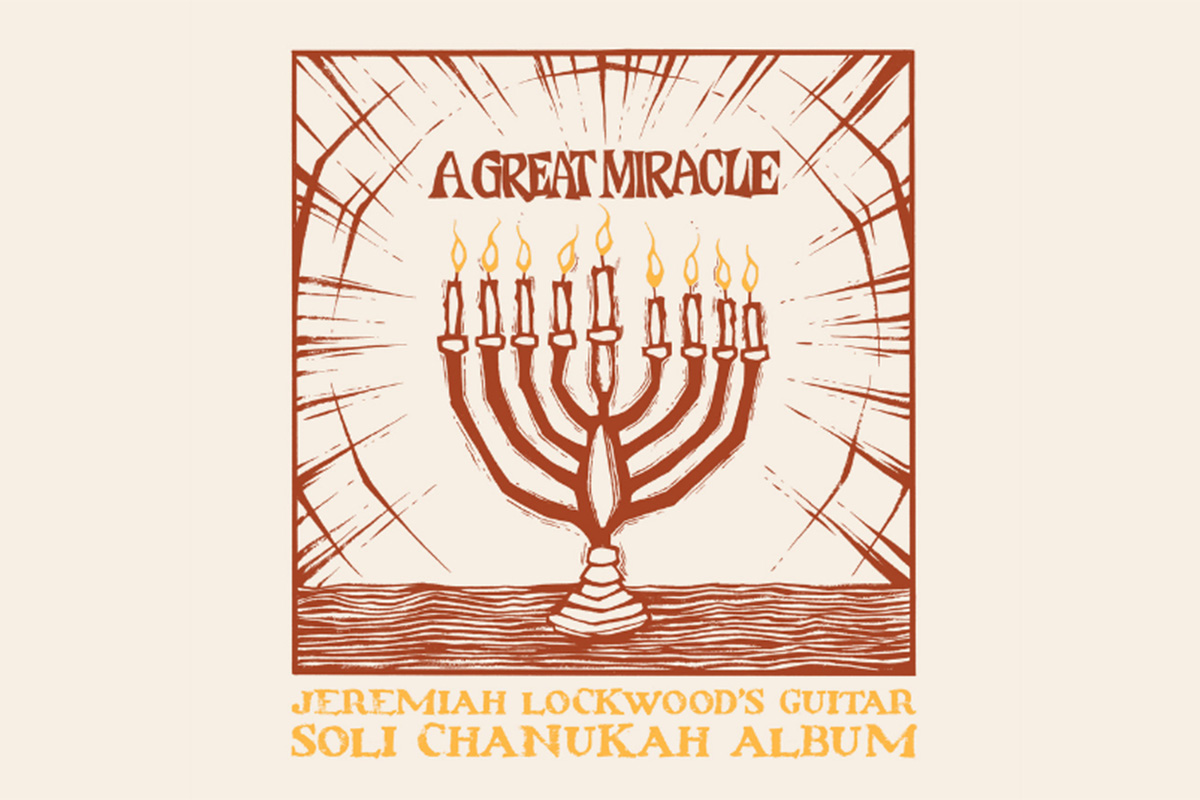The winter holidays have an inescapable soundtrack. Come November, if you turn on the radio, go to the mall (is that still a thing people do?) or stumble across a YouTube ad, there’s no mistaking that it’s “almost Christmas.” Obviously Mariah Carey reigns supreme, but there’s actually an absurd variety of Christmas musical moods available for your listening pleasure. Spotify offers curated playlists for “Christmas Pop,” “Country Christmas,” “Classical Christmas,” “Christmas Classics”… you see my point.
Don’t get me wrong: The single Jewish “Hanukkah” playlist on offer is great. Jews get Haim, Yo La Tengo and Sharon Jones — I am not complaining. Sometimes, though, on a cozy evening by a lit menorah, you might want some festive, soothing listening options that don’t start with Adam Sandler’s “The Chanukah Song.”
That album, a Jewish answer to “Christmas Peaceful Guitar,” has arrived. Musician Jeremiah Lockwood has collaborated with Reboot to release “A Great Miracle,” a “guitar soli Chanukah album.” The track list boasts all the Hanukkah standbys, from the warm folky “Ritual” which interprets the Hanukkah table blessing, to a bluesy “Little Dreydl,” to an intricate and bright “Maoz Tzur.”
Make no mistake — the musical caliber of this record is high, drawing on Lockwood’s extensive experience in two different and demanding modes of performance. Per Reboot: “Lockwood’s career has followed a unique path, with deep musical inspiration coming from two mentors. His grandfather Cantor Jacob Konigsberg (1921-2007) infused in him the melodies of the Jewish liturgy, with Lockwood performing in his choir. Lockwood credits his career as a guitarist to a decade-long apprenticeship with the legendary blues musician Carolina Slim, a.k.a. Elijah Staley (1926-2014), who passed down to Lockwood the Piedmont blues tradition of Brownie McGhee and Buddy Moss. Lockwood also leads the band Sway Machinery, which features Jordan McLean of Antibalis and at one point Brian Chase of the Yeah Yeah Yeahs.”
I spoke to Lockwood about how his bar mitzvah led to busking with the well-dressed Slim in Manhattan subways, about this album as an answer to Christmas music, and about a female Jewish music icon from history you should know.
This interview has been lightly condensed and edited for clarity.
I read that your guitar origin story started with your bar mitzvah. Is that true?
Perhaps there’s some truth to that. I started playing guitar a little before my bar mitzvah, and the bar mitzvah money was put to very good use. I bought a battery-powered amplifier and a little rig for busking, and I started my professional life from that. I made the money back very quickly.
I loved blues, and I loved old blues musicians. In those days, there were a few great elder blues musicians who played on the street [in New York City]. And I felt that I could become like them if I started doing what they did. I did that for many years — that was a big part of my life for a long, long time. It was hard to shake that idea. And I still have that idea in my head to some extent, although I don’t play on the street regularly anymore.
So at 13, you took your bar mitzvah-funded musical kit, and you went out and played… where?
My spot for the first year was mostly Columbus Circle. I played there pretty much every weekend when the weather was OK. And then in the summers, I did the street fairs. And those were great.
Who were some of the great New York City blues musicians playing on the street who inspired you?
There were two who were kind of the kings. There was Ted Williams, aka Floyd Lee. He passed away two or three years ago, and he was the first blues musician I got to be close with. He and his son had a duo called Ted and Ted, and they treated their busking like a show, they printed up posters. There was a big construction site on the Upper West Side that was kind of no man’s land. And they did a show there every Sunday. So that was quite inspiring to me as a kid.
Then there was Carolina Slim, who was a very different kind of person from Ted. Ted was of the bacchanalian, Dionysian strain of elder musicians, so everything was drinking — the first time I drank was with him and his son. There were wild parties, jokes, raucousness. Carolina Slim was very serious, very sober, didn’t drink or anything like that. Religious-minded, but a blues musician. I played with Carolina Slim. He was my very close teacher and friend; I played with him for decades. In addition to playing on the street, we played concerts. He didn’t really like to travel, so everything was pretty much local, but I worked with him very steadily for a long time. And he passed in 2014, but I still play his music. One of his other younger friends. Ricky Gordon, was a great drummer and percussionist. I just moved back to New York after a number of years in California, and we’ve been playing together all the time lately, which has been fantastic.
It’s funny that your Jewish coming-of-age somehow led to your musical one.
Yeah. Part of life for me. I was also very involved with Jewishness. I think it was harder for me to bring the two things together when I was younger. But that’s just been the ongoing process of trying to take the parts of life that society wants you to keep separate and find ways to subvert that and bring them bring them closer together. So I mean, I was singing with my grandfather, who was a great cantor, and my uncle’s also a cantor and my cousin’s a cantor, and other cousins, going back generations, you know. It’s a cantorial family. So that’s a big part of life for me as well. And I started a band, The Sway Machinery, which was trying to do something with that legacy and create music around it. We got started around 2006.
So you had these two musical identities: the Jewish one that you came by genetically and culturally, and then this bluesier one that you cultivated.
Something like that. I don’t think there’s anything new or strange about that. It’s a big part of American life — lots of history of musicians, especially Jewish, maybe white musicians, becoming interested in trying to find a way to express themselves through Black culture. I mean, that’s not really revolutionary or weird.
Like Benny Goodman.
Right. I think in a way, actually, trying to do something with cantorial music is weirder, probably. Because nobody really cares about that so much anymore. It’s pretty esoteric — old, old school, found on some records from the early 20th century. I’m very obsessed with that music as well. And I wrote my Ph.D. thesis about singers in the Hasidic community who are similarly obsessed with old cantorial records and who are revivalists of music. So there’s a scene.
You often feel you’ll be able to say the truth about this present moment if you can have access to what was true a long time ago, and music is one of the main ways that people try to go about getting that access to the ancient and the holy. Making up stories and beautiful, beautiful lies sometimes.
You mentioned that over time, you figured out how to integrate your various musical identities better. Can you tell me about that process?
Well, I think it’s just about trying to tell the whole story at the same time, all the time. And that’s, of course, very difficult because there are a lot of incentives to silo aspects of yourself — and also, not everything is appropriate for every situation.
I’ve done records that were sort of related to Jewish holidays before: the Kol Nidre record, “Hidden Melodies Revealed” with The Sway Machinery which came out of a project we did where we created a kind of concert event around Rosh Hashanah — it was our big breakout performance piece. This record is different. Hanukkah is a much more Christian holiday, I guess — as Jewish American cultural areas go, it’s Christmas, basically. So the idea that you’re going to make a Hanukkah record, or do Hanukkah music, means that you’re going to do Christmas music on some level. And that’s OK. I don’t have any reticence about that or feel that it’s wrong or bad. It’s just, you know, how are we going to find a way to get in on the action of this very American ritual of the transubstantiation of money into love — the very real beauty of the holidays? Well, we want to have that too. I think there’s sort of a poverty around it because people feel guilty or ashamed or bad about it. And I guess I don’t feel like that’s necessary.
This record is a Jewish Christmas record slash Christmas Hanukkah album. It’s very much inspired by a specific record: the John Fahey Christmas album.
John Fahey is a great musician and guitarist. It’s kind of funny, but one of his best records is what one would assume would be a kitschy throw-off. But it’s actually very beautiful: It’s a great record of him playing in a country blues style, these finger-picking arrangements of all the classic Christmas pieces. I’ve always liked that record a lot and played his arrangements of those pieces at different times over the years. And so I thought I’d expand it out, and pull in the childhood Hanukkah repertoire.
Even though I’m joking around about how Hanukkah is an impoverished holiday, there is a lot of music around it. As I mentioned, the family musical tradition was very rich for me growing up and so Hanukkah had this kind of concert feeing. We would light the candles and sing the brachas [blessings] in harmony, and accompany my grandfather singing cantorial pieces, on “Al HaNisim” and “Maoz Tzur” and different Hanukkah pieces. So the record goes in both directions — reaching outward into the American holiday ethos, and then also it’s a nostalgia piece. I allow myself a lot more softness on this record than I think I do on some of my other records, because it’s about childhood. It’s almost a kid’s record in some ways.
We all know that there is an enormous variety of instrumental Christmas music available — in a commercialized way, as you said. But I don’t know that I’d ever heard the equivalent Hanukkah album before. Was that in your head as a need that you were filling for the community when you wrote this?
Oh, definitely. There’s no question that it’s a problem. I’m not sure about the commercial prospects of any Jewish record, but in a way, it’s like, come on, man, we need this — like, make something that fits over here. It’s a functional record, I would say. If you want to put on a record that’s going to give a holiday vibe, but on a Jewish theme, this record will fill that function. I have no shame about it. There’s a product element to it.
I haven’t made a children’s record before, I haven’t made instrumental guitar music before. So there are a lot of things about it that are different from what I usually do. I’m not a person who engages with kitsch very much. I can be a little too serious, I would say — I’m a pretty serious kind of guy. This record has kind of lighthearted vibe in comparison to other things I’ve done, and that’s good. It’s needed. After the year that we had, you want to inject a note of levity.
I also think the record really does reward close listening, too. Each song is intricate and specific in its own way. How does your arranging process work?
It’s dependent on the instrumentation, of course. With the band, I was putting a lot of energy and thought into pulling on the different music that I love and artfully deploying sonic references in the way I arrange music. With this record, it’s different because it’s just all guitar, but it’s not completely different. There are a lot of allusions on the record, both to the John Fahey record that I mentioned before and in tribute to a half-dozen or so guitar heroes. Reverend Gary Davis, Elizabeth Cotten, Ali Farka Touré, Doc Watson. I’m pulling on a set of ideas from my fingerpicking guitar heroes.
Does it feel different to arrange, or work with, Jewish music as opposed to secular music?
It’s different. This record, in a way, is less different than singing Kol Nidre. There’s a certain ritual quality to singing liturgical music, where the text is actually from the siddur or the machzor and the line between art and davening is ambiguous. This record has less of that quality — although the first song is a theatrical reenactment of doing the ritual. So I don’t know, perhaps there’s something to that as well. That line between theater and ritual is being engaged.
Are any particularly beloved Jewish melodies or songs for you that you haven’t explored yet, and want to?
I’m in the middle of a new project with the Sway Machinery where we’re working with z’miros, the table melodies that are sung on Shabbat, and that record is going to be overlapping with this record in some ways, drawing on memories of my grandparents’ home. Less focused on synagogue, ritual music and more on the home experience. I’ve been playing with finding ways to include my grandmother’s presence in the music. She wasn’t a musician per se, but she created this atmosphere in which music existed and we were able to have these experiences. And I want to do something more with that feeling.
You mentioned you’re generally interested in old cantorial music, but are there particular Jewish musicians that you look up to you or admire in addition to that?
In the present day, I’m very involved with the Jewish music scene even though I don’t always fit in with it very easily. My music doesn’t fit neatly with the trends in the secular Jewish music world, and definitely not in the Orthodox Jewish music world.
I’m inspired by a bunch of Jewish musicians. I’ll name Zavel Kwartin, who was one of the first international stars of the gramophone era and sang cantorial music. He created some of the conventions of what we think of as being the cantorial sound in terms of cantors being a representation of the shtetl past. He saw himself as being someone who was preserving Jewish folk prayer music, and turning it into very powerful compositions that fit perfectly on one side of a 78 rpm record —creating these media objects out of the idea of the transcendent past.
And another person I’ll mention is called Goldy Malavsky — her family was the Malavsky Family Choir accompanying her dad, Samuel Malavsky. I do one of their pieces, the Al HaNisim, on this record — there are two versions of it, but one of them is with the Malavsky family melody. She’s one of my favorite voices in Jewish music. And she was a good deal before the liberal movement started ordaining women to be cantors, so she was in this gray-area period when American conventional synagogues didn’t know what to do with woman who sang cantorial music. She had to have her own kind of outsider career. They stopped singing in synagogues, basically, and they would put on High Holiday services in resorts and theaters and other unregulated spaces where they could do their highly traditional version of an Orthodox service, but with women’s voices as part of the music making. This year I have a research fellowship at UCLA in the ethnomusicology department, and I have to produce a blog post each week. I’m writing essays mostly based on interviews I do with contemporary Jewish musicians, but I also do some archival research pieces, and I did one on the Malavskys. So she’s one of my heroes, and she made a record, which is dynamite. It’s a great, great record.

Is there a song or a track on this album that you’re particularly happy with?
I don’t really have a favorite, but I do like the first one, “Ritual.” I was going for sort of an ethereal vibe with it, and also a nostalgic vibe, and it captures those feelings somewhat successfully. So I’m happy with that one.
Anything else that you want to tell me about this record? Or about you as a musician, or you as a historian?
I just want to talk to people with the music, to find chances to love people and give things and go easy on the world a little bit. And this record is part of that.



